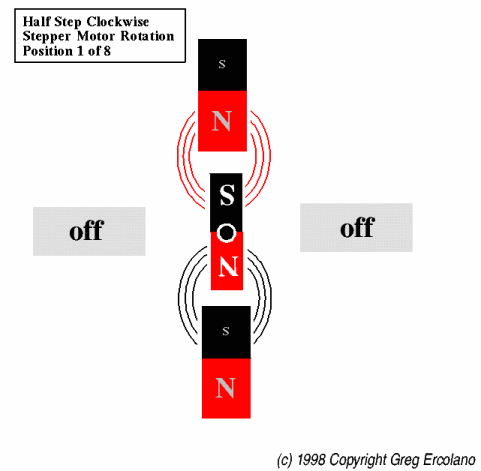 |

Stepper motors are uniquely suited for computer control. They are digital in nature, and if sequenced properly, can be completely manipulated by the computer with very simple hardware.
Stepper motors are used in the film industry, because rotational speed is extremely important to achieving consistent film exposure speeds, and for careful, accurate positioning of film transports and positioning.
Most stepper motors used in film control are 200 step motors that have four separate coils arranged in a pattern such that if the coils are energized in order, the motor turns. Each change in coil energizing is considered a 'step'. 200 steps (or 50 cycles through the four coil sequence) will move the motor one turn.
The order you energize the coils determines the direction of shaft movement. The speed at which you sequence through energizing the coils determines the rotational speed of the shaft.
If you stop sequencing the motor, leaving one coil energized, the motor will 'lock' to that position, and will resist turning. Motor braking can be achieved by slowing the motor down, then locking it.
There is a trick you can do to double the resolution of the motor; instead of just energizing one coil at a time in order, you can create positions inbetween by energizing the next coil in the sequence, before de-energizing the current coil. This also makes for smoother motion at slower speeds.
Stepper motors can be controlled with bipolar techniques, to strengthen the motor's ability to turn, and to lock. Rather than energizing single coils, one is energized with a positive voltage, while the opposite coil is given a negative voltage. Running a motor using bipolar techniques does NOT affect the resolution of the motor, only power and maximum running speed.
Here's an animated diagram showing a bi-polar half-step sequencing technique. Note that there are 8 half steps to this sequence. The rotor shaft is in the center, and is a fixed magnet. The four coils around it are energized in the order shown to achieve shaft rotation:
 |
The thing that's misleading about the above diagram is that it appears the shaft is making a full turn every cycle through energizing the four coils. Although such stepper motors exist, they only have an 4 steps of resolution (or in this case, 8 half-steps).
200 step motors need 50 such cycles (or 400 individual half steps) to achieve a full turn. Just one cycle through this 8 half-step sequence will yield only 1/50th of a turn, NOT a complete turn. This is because the coils are arranged in such a way that each coil is repeated several times throughout the motor's circumference, to increase the motor's resolution, and ability to achieve very slow speeds relatively smoothly. This isn't shown in the diagram, to keep it simple.
Chopper designs characteristically cause stepping motors to 'hum', even when the motor is in a locked position. However, modern choppers use such a high frequency now, that the humming is barely detectable.
High frequency chopping is relatively new, because until recently, transistors were not able to switch such large amounts of power quickly enough.
© Copyright 1997, Greg Ercolano.
All rights reserved. To report documentation errors, send email to
